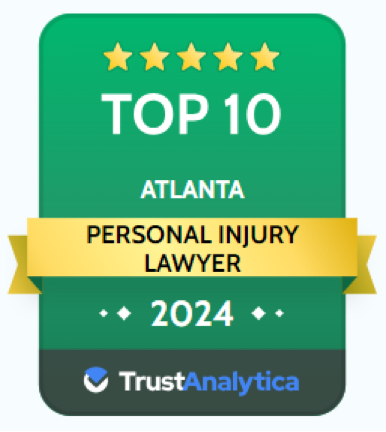All information provided about the law is very general in nature and should not be relied upon as legal advice. Every situation is different and should be analyzed by a lawyer who can provide individualized advice based on the facts involved in your unique situation, and a consideration of all of the nuances of the statutes and case law that apply at the time.
Who’s at Fault in a Weather-Related Accident?
Bad weather can come without warning. When sudden floods, severe winds, or hail storms arise when you’re on the road, panic can set in. And rightfully so– these conditions create dangerous situations, making the already precarious task of driving even riskier. For instance, the winter storm in the Peach State in January caused multiple car crashes and at least one death.
Storm conditions, including black ice and heavy rainfall, lead to numerous weather-related accidents throughout the year. When more than one vehicle is involved in a crash that can be partially attributed to inclement weather, determining fault can be complicated. If you’ve been involved in a weather-related accident where fault is unclear, call Montlick!
Montlick’s team of experienced, dedicated attorneys is here to fight on your behalf, ensuring you receive the proper compensation. With a proven track record of recovering billions for our clients, we are ready to review your claim and explore how we can assist you. You’re not alone in this.
Understanding Weather-Related Accidents
A weather accident refers to a car crash caused by severe conditions like rain, snow, sleet, hail, or fog. These accidents can lead to property damage, serious injuries, or even death. There are approximately 6,045,000 vehicle crashes each year. According to the same report from the Department of Transportation (DOT), car accidents due to weather conditions are responsible for 12% of all crashes in the United States.
Additional weather-related car accident statistics from the DOT as of 2023 include:
- 574,047 estimated crashes involving rain (7% of total weather-related accidents)
- 219,942 estimated crashes involving snow, sleet, hail, or freezing rain (18% of total weather-related accidents)
- 32,871 estimated crashes involving fog, smoke, smog, blowing snow, or blowing sand, soil, and dirt (4% of total weather-related accidents)
- 5,870 estimated crashes involving severe crosswinds (1% of weather-related accidents)
Determining Fault
Ultimately, while weather conditions can contribute to an accident, drivers are responsible for their driving behavior. A driver must adjust their habits based on road conditions. This falls under the category of “reasonable actions,” which considers different factors than normal road conditions. For example, if a speed limit is posted as 55, it may not be “reasonable” to drive at that speed in poor conditions. A driver could be at fault for an accident if they did not:
- Reduce speed
- Maintain a safe following distance
- Use appropriate caution with reduced visibility
- Ensure the vehicle is properly maintained
Other factors considered when determining fault in a car accident include intoxication and distraction. If it is found that weather conditions were not severe enough to contribute, such as minimal rainfall and poor visibility, then non weather related negligence may be a factor. In a rear-end collision the rear driver is typically presumed to be at fault; however, there are exceptions where the front driver may also be liable. In a single car accident due to weather, you’ll most likely be found entirely at fault, but there are also exceptions to that general rule.
What to Do After A Weather-Related Accident
Experiencing a car accident in the rain can be anxiety-inducing. However, the time immediately following an accident is crucial for retaining valuable evidence and building a strong case. Here’s what you should do after a weather-related accident. Remember, we’re here to guide you through this process.
- Check for injuries. First, check yourself and others in your vehicle for injuries. If everyone in the car is okay, see if you can help others involved.
- Call 911. After checking on all the involved parties, call emergency services. It’s essential that during the call, you provide as much information as possible so dispatchers can ensure the appropriate number of ambulances arrive to offer medical assistance.
- Move to safety. Once first responders are on their way, move your vehicle off the road and turn on your hazards. This clears a path for those arriving to help and minimizes the chance of another accident.
- Exchange information. Remember to obtain the contact information of everyone involved in the crash. The gathered information should include full names, addresses, insurance companies, phone numbers, email addresses, and vehicle details. When speaking with them, stick to the outlined information and avoid discussing anything else. Be courteous, but do not apologize or admit any responsibility.
- Document the scene. If safe, take photos of accident damage on both vehicles, along with any skid marks or debris, if it is safe and reasonable. Obtain contact and insurance details from the involved drivers. Additionally, talk to eyewitnesses at the scene and gather their contact information.
- Seek medical attention. Accept any immediate medical care offered at the scene after a weather accident. Even if your injuries don’t seem serious, visit urgent care or your primary care doctor for an evaluation, ideally within the first 24 hours. Having medical records can help prevent insurance companies from denying that your injuries are related to the accident.
- Call Montlick. The sooner you speak with a personal injury attorney, the better. We can review the details of your accident and decide if pursuing compensation for medical bills, lost wages, long-term care, or other damages is appropriate. Additionally, the earlier we start our investigation, the less likely it is that critical evidence will have been lost or destroyed.
Tips to Stay Safe During Inclement Weather
Bad weather is more than just an inconvenience; it poses a hazard to drivers. Wet roads, poor visibility, and strong winds increase the danger. While you can’t control the weather, you can control how you respond to it. Don’t be a victim – follow these rules for driving in severe weather:
- Slow down
- Follow all traffic laws
- Increase the following distance
- Avoid sudden braking or steering
- Use low beams for better visibility in fog
- Plan for increased stopping distance
- Watch for black ice
- Keep headlights on
- Check weather conditions before driving
Overall, prepare as best as you can. Always make sure there’s an ice scraper in your car and check your tires, brakes, battery, and antifreeze levels before winter begins. Keep a ready emergency kit that includes food, a blanket, a flashlight, water, and any other essentials you might need. Most importantly, if possible, stay off the road during severe weather to minimize the chances of a car accident in the rain or other inclement weather.
Fierce, Compassionate Legal Help. That’s the Montlick Method.
Whether you have been involved in a single car accident due to weather or a multi-vehicle weather-related accident, you need a legal team you can rely on. Your focus should be entirely on healing and moving forward.
While you recover from the crash, we’ll do our best to build a strong case and fight so that you receive the maximum possible compensation.
The Montlick promise is this: we’ll fight for justice for you, your family, and your future. What are you waiting for? Let someone from our team review your case and get started today. Call today to schedule your 100% free, no-obligation consultation.
How useful is this for you?
Would you like to speak with an attorney?
Call NowRelated Questions
- How Long Will My Georgia Car Accident Case Take?
- Can Cell Phone Data Be Used As Evidence In A PI Case?
- How Can a Personal Injury Attorney Get Me More Compensation After a Car Accident?
- Can I Get Traffic Camera Footage of My Car Accident in Georgia?
- What Happens If Someone Else is Driving My Car and Gets in an Accident?
We Win More than Settlements.
We win the peace-of-mind you need to get your life back.
At Montlick, we believe comprehensive legal representation is a right, not a privilege. That’s why we provide our services on a contingency fee basis. You only pay when we win.









